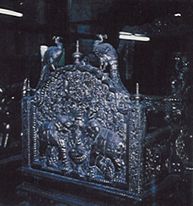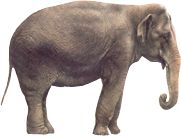|
|


In
the long history of Man, stretching back to his emergence from the
mists of pre-history, a most remarkable and amazing feature has been
his mastery of the elephant, the largest of creatures on land, which
have been domesticated and trained to serve him. Pre-historic Man was
in awe of the giant mastodon and the great woolly mammoth, the early
cousin of the modern elephant. He hunted them for the plentiful meat
and sinew it provided, for the large bones and thick hides, which gave
him shelter, and for the shiny ivory it yielded for making his adornments.
This bounty came in good use for him to survive in the harsh cold climate.
 With
the passage of time man learnt to capture, train and adopt the elephant
to serve his needs. In India and other lands of Asia, where Hindu and
Buddhist religion found roots and flourished, the elephant found a special
place in the link with religion. The Hindu God of Learning, Wisdom and
Destroyer of Evil - Lord Ganapati or Ganesha - has the head of an elephant.
The famous mount or "Vahan" of Lord Indra, the God of Rain is Erawat
- the celestial white elephant, normally depicted with quadruple tusks
and at times with multiple trunks. Our great epic the "Mahabharat" has
many interesting references about elephants. As such, the elephant is
held in veneration by many, is generally by far the most popular of
all animals and loved by all children. With
the passage of time man learnt to capture, train and adopt the elephant
to serve his needs. In India and other lands of Asia, where Hindu and
Buddhist religion found roots and flourished, the elephant found a special
place in the link with religion. The Hindu God of Learning, Wisdom and
Destroyer of Evil - Lord Ganapati or Ganesha - has the head of an elephant.
The famous mount or "Vahan" of Lord Indra, the God of Rain is Erawat
- the celestial white elephant, normally depicted with quadruple tusks
and at times with multiple trunks. Our great epic the "Mahabharat" has
many interesting references about elephants. As such, the elephant is
held in veneration by many, is generally by far the most popular of
all animals and loved by all children.
It
is depicted as a motif for decoration, in various styles and idioms
in innumerable temples, palaces and monuments throughout India and also
in other Asian lands. The monolithic black-stone elephant of the Kailash
cave at Ellora is very famous, as are the elephant studies in Mughal
miniature paintings. But the best renderings of elephants are to be
found in the Kotah Miniatures Paintings where the large animal is drawn
with rare beauty, flowing strokes and rhythmic grace showing the power
and energy of this big animal.
 The
Indian elephant, known in zoological nomenclature as elephas maximus
indicus is the second largest creature in the animal kingdom, after
its bigger African cousin - loxodonta africana. A big bull tusker can
weigh between 4 - 6 tons, stands around 10 - 11 feet tall at its shoulders,
and can carry tusks of around 8 - 8 feet long weighing up to 100 lbs.
Each. It is known for its highly sensitive and keen senses of hearing
and smell, for its well developed intelligence which makes it obey human
commands and is credited with a long memory. However its eyesight is
poor. Elephants walk at speed of around 4 m.p.h., but can "run" in short
bursts of speeds up to 15 m.p.h., which is best described as an ambling
shuffle. An angry elephant is a terrifying sight to behold and when
it decides to charge an enemy, only a brave person with presence of
mind can escape being gored and trampled to death. Generally the elephant
is a well behaved and a gentle animal and is known to live long even
in captivity. In its natural habitat it is constantly feeding or browsing.
It consumes around 500 lbs. of feed in captivity which can be fodder,
green grass, tree leaves, sugar-cane, wheat cakes or "roth" mixed with
ghee, gur and a bit of salt. They love water and are strong swimmers.
In the heat they spray themselves with water brought out of their body
via their trunks. The trunk of an elephant is a sensitive organ and
is also very strong. The
Indian elephant, known in zoological nomenclature as elephas maximus
indicus is the second largest creature in the animal kingdom, after
its bigger African cousin - loxodonta africana. A big bull tusker can
weigh between 4 - 6 tons, stands around 10 - 11 feet tall at its shoulders,
and can carry tusks of around 8 - 8 feet long weighing up to 100 lbs.
Each. It is known for its highly sensitive and keen senses of hearing
and smell, for its well developed intelligence which makes it obey human
commands and is credited with a long memory. However its eyesight is
poor. Elephants walk at speed of around 4 m.p.h., but can "run" in short
bursts of speeds up to 15 m.p.h., which is best described as an ambling
shuffle. An angry elephant is a terrifying sight to behold and when
it decides to charge an enemy, only a brave person with presence of
mind can escape being gored and trampled to death. Generally the elephant
is a well behaved and a gentle animal and is known to live long even
in captivity. In its natural habitat it is constantly feeding or browsing.
It consumes around 500 lbs. of feed in captivity which can be fodder,
green grass, tree leaves, sugar-cane, wheat cakes or "roth" mixed with
ghee, gur and a bit of salt. They love water and are strong swimmers.
In the heat they spray themselves with water brought out of their body
via their trunks. The trunk of an elephant is a sensitive organ and
is also very strong.
In
India the elephant has been traditionally associated with royalty
from days immemorial. It was used by the king for ceremonial purposes,
as a royal mount and as a mobile fortress in war. They were stabled
in "pheelkhanas", with a mahout and 3 or 4 "charkattas" or grass-cutters
assigned to each animal. It was their job to look after the animal,
to feed and keep him well. From the earliest times, the elephant formed
a separate corps of the fighting army in India. A war elephant was specially
trained and fitted out with heavy plate armour or chain-mail, carrying
up to 4 armed warriors in the armoured howdah. Wielding a sabre held
in its trunk, the mighty war elephant was meant to strike terror in
the hearts of the foe and un-nerve the enemy cavalry horses. The first
well know European to come face to face with Indian war elephants was
Alexander the Great. Later his Satrap, Saleukos Nikator got soundly
defeated by Chandragupta Maurya- who had over 500 war elephants in his
army. The Romans got a taste of African elephants when Hannibal descended
across the Alps into the Italian mainland and gave them a string of
bitter defeats. Famous Romans, like Pompey and Julius Caesar used African
elephants as the prized showpieces in their Triumphs held in Rome. The
great Mughal Emperor Akbar was particularly fond of elephants and took
delight in riding even a musth elephant all alone. He went on expeditions
to catch wild ones, maintained a large number of them in his royal stables
and used them in war. Emperor Jehangir records in his diary that there
were 12,000 elephants maintained by the Emperor. Hindu Kings and Princes,
and high officials and dignitaries of the realm also kept them. A staggering
number of around 100,000 such elephants were kept and maintained in
Hindustan in those days! Today there are only about 25,000 wild ones
in India!
A
whole separate branch of science and medical knowledge came in existence
in the matter of looking after, care and in the treatment of ailments
of these animals, all carefully researched and codified and written
as treatises. These books were in Sanskrit, Hindi and later also in
Persian. The war elephant held its own on the battlefield till the 16th
century. The advent of gunpowder, cannon and firearms spelt its doom.
Thereafter the elephant remained largely for ceremonial purposes as
the mighty mount for a Prince. Of course, it remained an excellent haulier,
was extensively used in shikar and sometimes also as an executioner.
A royal procession consisting of many gaily decorated, richly caparisoned
and adorned elephants, bearing flags, nakkaras, emblems of royalty and
honours like the Mahi-o=Maratib, with the nobles and the King - was
a rare and wonderful sight. I have had the privilege to have taken part
in such royal processions riding in a silver howdah atop a big tusker.
The Kotah state maintained around 25 elephants. The grandest animals
in our stables as far as I can remember were two big tuskers - "Chanchalgaj"
and "Gadhe Bahadur". I have ridden the latter in my marriage procession
and been on it several times in shikar. It was a brave elephant a who
stood unflinchingly like a rock even when the tiger charged it! Such
elephants even in those days were a rarity and hard to train. Alas -
with the change of times all these things have now disappeared and only
remain as good memories.
It
is my pleasure to write this introduction to the book "Jhools in
the Dust" written by Mrs. Greta Palmer. I have known her now for around
8-9 years. She first got in touch with me when she was starting to do
her book. How she learnt about me is a bit of a mystery. She had several
queries and I tried to answer then, satisfactorily I hope. She has been
to Kota several times since 1993 and it was a pleasure to have her and
her husband. Mrs Palmer has been very pains-taking and diligent in her
efforts to visit far flung places and ferret out information, which
is now getting to be increasing rare. The final work has turned out
to be very interesting and shall prove to be instructive to all persons
who have a love of history and the Indian elephant.

|